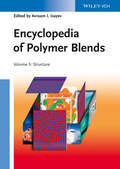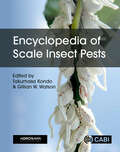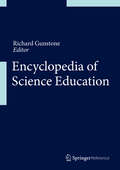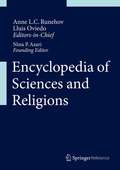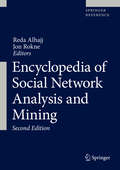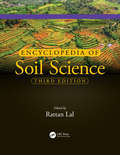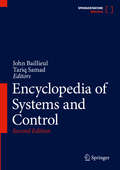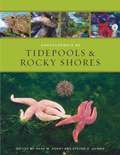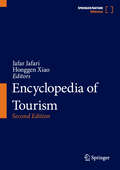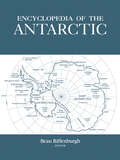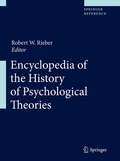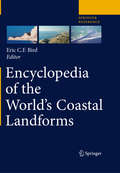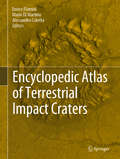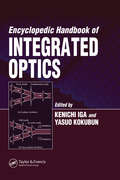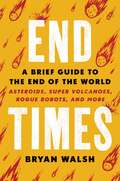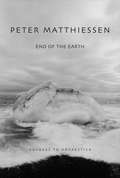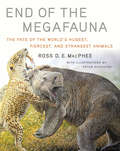- Table View
- List View
Encyclopedia of Polymer Blends, Volume 3: Structure (Encyclopedia of Polymer Blends)
by Avraam I. IsayevA complete and timely overview of the topic, this Encyclopedia imparts knowledge of fundamental principles and their applications for academicians, scientists and researchers, while informing engineers, industrialists and entrepreneurs of the current state of the technology and its utilization. The most comprehensive source on polymer blends available on the market Offers a complete and timely overview of the topic Each article presents up to date research & development on a topic and its basic principles and applications, integrates case studies, laboratory and pilot plant experiments, and gives due reference to published and patented literature Equips academics, scientists and researchers with knowledge of fundamentals principles and their applications, and informs the engineers, industrialists and entrepreneurs about the state of the art technology and its applications
Encyclopedia of Radiation Oncology
by Luther W. Brady Jay E. Reiff Reiner Class Stephan Mose Theodore YaegerThe aim of this comprehensive encyclopedia is to provide detailed information on radiation oncology. The wide range of entries are written by leading experts. They will provide basic and clinical scientists in academia, practice and industry with valuable information about the field of radiation oncology. Those in related fields, students, teachers, and interested laypeople will also benefit from the important and relevant information on the most recent developments.
Encyclopedia of Renewable Energy
by James G. SpeightENCYCLOPEDIA OF RENEWABLE ENERGY Written by a highly respected engineer and prolific author in the energy sector, this is the single most comprehensive, thorough, and up-to-date reference work on renewable energy. The world’s energy industry is and has always been volatile, sometimes controversial, with wild swings upward and downward. This has, historically, been mostly because most of our energy has come from fossil fuels, which is a finite source of energy. Every so often, a technology comes along, like hydrofracturing, that is a game-changer. But is it, really? Aren’t we just delaying the inevitable with these temporary price fixes The only REAL game-changer is renewable energy. For decades, renewable energy sources have been sought, developed, and studied. Sometimes wind is at the forefront, sometimes solar, and, for the last decade or so, there has been a surge in interest for biofeedstocks and biofuels. There are also the “old standbys” of nuclear and geothermal energy, which have both been around for a very long time. This groundbreaking new volume presents these topics and trends in an encyclopedic format, as a go-to reference for the engineer, scientist, student, or even layperson who works in the industry or is simply interested in the topic. Compiled by one of the world’s best-known and respected energy engineers, this is the most comprehensive and up-to-date encyclopedia of renewable energy ever written, a must-have for any library. Encyclopedia of Renewable Energy: Is written in an encyclopedic style, covering every aspect of renewable energy, including wind, solar, and many other topics Offers a comprehensive coverage of the industry, from the chemical processes of biofeedstocks and biofuels to the machinery and equipment used in the production of fuel and power generation Is filled with workable examples and designs that are helpful for practical applications Covers the state of the art, an invaluable resource for any engineer Audience Engineers across a variety of industries, including wind, solar, process engineering, waste utilization for fuels, and many others, such as process engineers, chemical engineers, electrical engineers, petroleum engineers, civil engineers, and the technicians and other scientists who work in this field
Encyclopedia of Scale Insect Pests
by Helen Harman Jan H. Giliomee Jocelyn A. Berry Manuela Branco Lyle Buss Mr Alejandro Caballero Mr Juang Horng Chong Lucía E. Claps C. De Klerk Rodrigo Diaz Imre Foldi Antonio P. Garonna Ilya A. Gavrilov-Zimin Raymond J. Gill Penny J. Gullan Disna N. Gunawardana Sunil Joshi M. Bora Kaydan Paris L. Lambdin Yen-Po Lin Christopher Malumphy Zvi Mendel Vitor Cezar Pacheco da Silva Giuseppina Pellizzari Ana Lúcia Peronti Francesco Porcelli Alex Protasov Ting-Kui Qin Andrea Amalia Ramos Portilla Dewi Sartiami Scott A. Schneider U.G.A.I. Sirisena Pompeo Suma Éva Szita Hirotaka TanakaScale insects feed on plant juices and can easily be transported to new countries on live plants. They sometimes become invasive pests, costing billions of dollars in damage to crops worldwide annually, and farmers try to control them with toxic pesticides, risking environmental damage. Fortunately, scale insects are highly susceptible to control by natural enemies so biological control is possible. They have unique genetic systems, unusual metamorphosis, a broad spectrum of essential symbionts, and some are sources of commercial products like red dyes, shellac and wax. There is, therefore, wide interest in these unusual, destructive, beneficial, and abundant insects. The Encyclopedia of Scale Insect Pests is the most comprehensive work on worldwide scale insect pests, providing detailed coverage of the most important species (230 species in 26 families, 36% of the scale insect pest species known). Advice is provided on collection, preservation, slide-mounting, vouchering, and labelling of specimens, fully illustrated with colour photographs, diagrams and drawings. Pest species are presented in two informal groups of families, the 'primitive' Archaeococcoids followed by the more 'advanced' Neococcoids, covered in phylogenetic order. Each family is illustrated and diagnosed based on features of live and slide-mounted specimens, with information on numbers of genera and species, main hosts, distribution, and biology. For the important pest species, coverage includes information on the morphology of live and slide-mounted specimens, common names, principal synonyms, geographical distribution, plant hosts, plant damage and economic impact, reproductive biology, dispersal, and management strategies including biological, cultural and chemical control, sterile insect techniques, regulatory control, early warning systems and field monitoring. An additional complete list of scale insect pests worldwide is provided, comprising 642 species in 28 scale insect families (about 8% of the 8373 species of living scales known), with information on plant hosts, geographical distribution and validation sources. Beneficial uses of scale insects include sources of red dyes, natural resins and waxes, and agents for invasive weed control, alongside the importance of their honeydew to bees for making honey, and as a food source to other animals. Academic researchers, students, entomologists, pest management officials in agribusiness or government including plant quarantine identifiers, extensionists, farmers, field scientists and ecologists will all benefit from this book.
Encyclopedia of Science Education
by Richard GunstoneThe "Encyclopedia of Science Education" provides a comprehensive reference work covering the range of methodologies, perspectives, foci, and cultures of this field of inquiry, and to do so via contributions from leading researchers from around the globe. Because of the frequent ways in which scholarship in science education has led to developments in other curriculum areas, the encyclopediahas significance beyond the field of science education. The "Encyclopedia of Science Education" is a comprehensive and genuinely international reference work, and is aimed at graduate students, researchers, developers in science education and science education research. The topics to be covered encompass all areas of science education and it includes biographical entries on science educators, as well as educators whose work has had an impact on science education as a research field. "
Encyclopedia of Sciences and Religions
by Anne Runehov Lluis OviedoThe Encyclopedia of Sciences and Religions will map the (self-)identities of current and prospective participants in a scholarly area 'Science and Religion' - i.e., all academic disciplines, religious traditions, across all cultures - by implicitly drawing out from each how it sees itself in relation to the conceptual domains of 'Science' and 'Religion', how each, within its own disciplinary/tradition bounds, treats a set of key issues/themes/concepts that have thus far emerged as central to the area 'Science and Religion', and also additional issues/themes/concepts that are seen to be of relevance to 'Science and Religion' engagement as seen from the perspective of each potential participant therein. Special entries will be devoted to key thinkers and key concepts in the field. The Encyclopedia will provide not only a comprehensive, up-to-date picture of how a so-called 'Science and Religion' discourse/dialogue has thus far been treated, but as well, a starting point for new lines of inquiry, and an invitation for fresh perspectives on the possibilities for engagement between and across sciences and religions.
Encyclopedia of Signaling Molecules
by Sangdun ChoiBiological processes are driven by complex systems of functionally interacting signaling molecules. Thus, understanding signaling molecules is essential to explain normal or pathological biological phenomena. A large body of clinical and experimental data has been accumulated over these years, albeit in fragmented state. Hence, systems biological approaches concomitant with the understanding of each molecule are ideal to delineate signaling networks/pathways involved in the biologically important processes. The control of these signaling pathways will enrich our healthier life. Currently, there are more than 30,000 genes in human genome. However, not all the proteins encoded by these genes work equally in order to maintain homeostasis. Understanding the important signaling molecules as completely as possible will significantly improve our research-based teaching and scientific capabilities. This encyclopedia presents 350 biologically important signaling molecules and the content is built on the core concepts of their functions along with early findings written by some of the world's foremost experts. The molecules are described by recognized leaders in each molecule. The interactions of these single molecules in signal transduction networks will also be explored. This encyclopedia marks a new era in overview of current cellular signaling molecules for the specialist and the interested non-specialist alike During past years, there were multiple databases to gather this information briefly and very partially. Amidst the excitement of these findings, one of the great scientific tasks of the coming century is to bring all the useful information into a place. Such an approach is arduous but at the end will infuse the lacunas and considerably be a streamline in the understanding of vibrant signaling networks. Based on this easy-approach, we can build up more complicated biological systems.
Encyclopedia of Social Network Analysis and Mining
by Jon Rokne Reda AlhajjSocial Network Analysis and Mining Encyclopedia (ESNAM) is the first major reference work to integrate fundamental concepts and research directions in the areas of social networks and applications to data mining. The second edition of ESNAM is a truly outstanding reference appealing to researchers, practitioners, instructors and students (both undergraduate and graduate), as well as the general public. This updated reference integrates all basics concepts and research efforts under one umbrella. Coverage has been expanded to include new emerging topics such as crowdsourcing, opinion mining, and sentiment analysis. Revised content of existing material keeps the encyclopedia current. The second edition is intended for college students as well as public and academic libraries. It is anticipated to continue to stimulate more awareness of social network applications and research efforts.The advent of electronic communication, and in particular on-line communities, have created social networks of hitherto unimaginable sizes. Reflecting the interdisciplinary nature of this unique field, the essential contributions of diverse disciplines, from computer science, mathematics, and statistics to sociology and behavioral science, are described among the 300 authoritative yet highly readable entries. Students will find a world of information and insight behind the familiar façade of the social networks in which they participate. Researchers and practitioners will benefit from a comprehensive perspective on the methodologies for analysis of constructed networks, and the data mining and machine learning techniques that have proved attractive for sophisticated knowledge discovery in complex applications. Also addressed is the application of social network methodologies to other domains, such as web networks and biological networks.
Encyclopedia of Soil Science
by Rattan LalNew and Improved Global Edition: Three-Volume Set A ready reference addressing a multitude of soil and soil management concerns, the highly anticipated and widely expanded third edition of Encyclopedia of Soil Science now spans three volumes and covers ground on a global scale. A definitive guide designed for both coursework and self-study, this latest version describes every branch of soil science and delves into trans-disciplinary issues that focus on inter-connectivity or the nexus approach. For Soil Scientists, Crop Scientists, Plant Scientists and More A host of contributors from around the world weigh in on underlying themes relevant to natural and agricultural ecosystems. Factoring in a rapidly changing climate and a vastly growing population, they sound off on topics that include soil degradation, climate change, soil carbon sequestration, food and nutritional security, hidden hunger, water quality, non-point source pollution, micronutrients, and elemental transformations. New in the Third Edition: Contains over 600 entries Offers global geographical and thematic coverage Entries peer reviewed by subject experts Addresses current issues of global significance Encyclopedia of Soil Science, Third Edition: Three Volume Set expertly explains the science of soil and describes the material in terms that are easily accessible to researchers, students, academicians, policy makers, and laymen alike. Also Available OnlineThis Taylor & Francis encyclopedia is also available through online subscription, offering a variety of extra benefits for researchers, students, and librarians, including: Citation tracking and alerts Active reference linking Saved searches and marked lists HTML and PDF format options Contact Taylor and Francis for more information or to inquire about subscription options and print/online combination packages.US: (Tel) 1.888.318.2367; (E-mail) e-reference@taylorandfrancis.comInternational: (Tel) +44 (0) 20 7017 6062; (E-mail) online.sales@tandf.co.uk
Encyclopedia of Systems and Control
by John Baillieul Tariq SamadThe Encyclopedia of Systems and Control collects a broad range of short expository articles that describe the current state of the art in the central topics of control and systems engineering as well as in many of the related fields in which control is an enabling technology. The editors have assembled the most comprehensive reference possible, and this has been greatly facilitated by the publisher’s commitment to continuously publish updates to the articles as they become available in the future. Although control engineering is now a mature discipline, it remains an area in which there is a great deal of research activity, and as new developments in both theory and applications become available, they will be included in the online version of the encyclopedia. A carefully chosen team of leading authorities in the field has written the well over 300 articles, 50 of them new in the second edition. The topics range from basic principles of feedback in servomechanisms to advanced topics such as the control of Boolean networks and evolutionary game theory and this range has also been expanded to include material on such subjects as the Internet of Things, quantum control and smart grids. Because the content has been selected to reflect both foundational importance and subjects that are of current interest to the research and practitioner communities, a broad readership that includes students, application engineers, and research scientists will find entries that are of interest.
Encyclopedia of Tidepools and Rocky Shores
by Steven D. Gaines Mark W. DennyThis comprehensive encyclopedia is an authoritative, one-stop reference for everyone interested in the biology and ecology of the fascinating and uniquely accessible environment. Conveniently arranged alphabetically, nearly 200 wide-ranging entries written in clear language by scientists from around the world provide a state of the art picture of tidepools and rocky shore science.
Encyclopedia of Time: Science, Philosophy, Theology, & Culture
by H. James Birx"With a strong interdisciplinary approach to a subject that does not lend itself easily to the reference format, this work may not seem to support directly academic programs beyond general research, but it is a more thorough and up-to-date treatment than Taylor and Francis's 1994 Encyclopedia of Time. Highly recommended."—Library Journal STARRED ReviewSurveying the major facts, concepts, theories, and speculations that infuse our present comprehension of time, the Encyclopedia of Time: Science, Philosophy, Theology, & Culture explores the contributions of scientists, philosophers, theologians, and creative artists from ancient times to the present. By drawing together into one collection ideas from scholars around the globe and in a wide range of disciplines, this Encyclopedia will provide readers with a greater understanding of and appreciation for the elusive phenomenon experienced as time. Features Surveys historical thought about time, including those ideas that emerged in ancient Greece, early Christianity, the Italian Renaissance, the Age of Enlightenment, and other periodsCovers the original and lasting insights of evolutionary biologist Charles Darwin, physicist Albert Einstein, philosopher Alfred North Whitehead, and theologian Pierre Teilhard de Chardin Discusses the significance of time in the writings of Isaac Asimov, Samuel Taylor Coleridge, Fyodor M. Dostoevsky, Francesco Petrarch, H. G. Wells, and numerous other authorsContains the contributions of naturalists and religionists, including astronomers, cosmologists, physicists, chemists, geologists, paleontologists, anthropologists, psychologists, philosophers, and theologiansIncludes artists' portrayals of the fluidity of time, including painter Salvador Dali's The Persistence of Memory and The Discovery of America by Christopher Columbus, and writers Gustave Flaubert's The Temptation of Saint Anthony and Henryk Sienkiewicz's Quo VadisProvides a truly interdisciplinary approach, with discussions of Aztec, Buddhist, Christian, Egyptian, Ethiopian, Hindu, Islamic, Navajo, and many other cultures' conceptions of timeKey ThemesBiographyBiology/EvolutionCulture/HistoryGeology/PaleontologyPhilosophyPhysics/ChemistryPsychology/LiteratureReligion/TheologyTheories/Concepts
Encyclopedia of Tourism
by Jafar Jafari Honggen XiaoThis encyclopedia is the most comprehensive and updated source of reference in tourism research and practice. It covers both traditional and emerging concepts and terms and is fully international in its scope. Some 769 entries by 871 internationally renowned experts from 124 countries provide a definitive access to the knowledge of tourism and its related fields. Users will find reliable and up-to-date definitions and explanations of the key terms of tourism in this reference book. Tourism is the largest industry in the world and is the main source of income for many countries. With the practical impact of worldwide tourism and the growing number of academic programs and institutions devoted to its education and research, this encyclopedia is the epicenter of this emerging and developing discipline. Editorial BoardManaging Editor: Amy Osmond Associate Editors: David Airey, Nevenka Cavlek, Peter U. C. Dieke, Juergen Gnoth, Maria Gravari-Barbas, Tazim Jamal, Kumi Kato, Francisco Madrid Flores, Yoel Mansfeld, Scott M. Meis, Regina Schlüter, Noel Scott, Honggang XuResource Editor: Beka JakeliAssistant Editors: S. Vida Muse, Peter Reim, Shun YeCartographers: Kisandul Kumarasinghe, Ashan Manamperi, Himanshi Withanage
Encyclopedia of the Antarctic
by Beau RiffenburghThe Antarctic is unique, geographically, politically, and scientifically. It is the most remote, hostile, and dangerous continent, while at the same time it is the most pristine and least developed. Antarctica is the only major part of the Earth's landmass not directly governed by one nation, but under the control of a Treaty, with a multitude of acceding nations. The Encyclopedia of the Antarctic brings together large quantities of information on the wide variety of factors, issues and individuals influencing and relating to the Antarctic. No comparable book currently exists for this region.The Encyclopedia of the Antarctic discusses scientific activities and topics, but the 'human element' is also a significant part of the work, with entries on history, politics, legal issues, national research programs, scientific bases, historic huts, the United Nation's 'Question of Antarctica,' compliance with the Environmental Protocol, and tourism.
Encyclopedia of the History of Astronomy and Astrophysics
by David LeveringtonThis comprehensive Encyclopedia covers the full history of astronomy from its ancient origins in Africa, South America, the Middle East and China to the latest developments in astrophysics and space-based research. The initial articles, which are largely organised chronologically, are followed by numerous thematic historical articles on the constituents of the Solar System, types of stars, stellar evolution, active galaxies, cosmology and much more. These are followed by articles on tools and techniques, from the history of spectroscopy to adaptive optics. The last part of the Encyclopedia is devoted to the history of ground- and space-based telescopes and observatories, covering the full spectral range from gamma-rays through the optical waveband to radio waves. Informative and accessibly written, each article is followed by an extensive bibliography to facilitate further research, whilst consistent coverage from ancient times to the present makes this an ideal resource for scholars, students and amateur astronomers alike.
Encyclopedia of the History of Psychological Theories
by Robert W. RieberThis work will survey the entire range of thinking in psychology, from ancient times to the present, encompassing philosophies and theories of mind that pre-date our modern conception of psychology as a science, and extending to the current findings of neuroscience. It will set the theories into their historical context and cross-reference key influences, such as Darwin's on Freud. Fifteen hundred entries will comprise key figures, theoretical concepts, false theories, historical events, and seminal writings. International in scope, this project will involve history of psychology experts from around the world and the coverage of topics will be set in global context. The aim will be to provide a reference work of more depth than discussions that are currently available in textbooks, with the ability to connect to a multitude of relevant topics. This work will provide a picture of psychology as it has emerged into the present time and position it among other related fields such as anthropology, sociology, philosophy, and medicine.
Encyclopedia of the World's Coastal Landforms
by Eric BirdThis unique richly-illustrated account of the landforms and geology of the world's coasts, presented in a country-by-country (state-by-state) sequence, assembles a vast amount of data and images of an endangered and increasingly populated and developed landform. An international panel of 138 coastal experts provides information on "what is where" on each sector of coast, together with explanations of the landforms, their evolution and the changes taking place on them. As well as providing details on the coastal features of each country (state or county) the compendium can be used to determine the extent of particular features along the world's coasts and to investigate comparisons and contrasts between various world regions. With more than 1440 color illustrations and photos, it is particularly useful as a source of information prior to researching or just visiting a sector of coast. References are provided to the current literature on coastal evolution and coastline changes.
Encyclopedic Atlas of Terrestrial Impact Craters
by Enrico Flamini Mario Di Martino Alessandro ColettaThis comprehensive atlas explains the genesis and evolution of impact known craters on Earth, presenting a wealth of radar images from the Italian COSMO-SkyMed satellites that were acquired at the same frequency, spatial resolution, operating mode, and illumination, allowing excellent comparison of different impact structures. It also discusses in detail the processes that have hidden or erased terrestrial impact craters, and clearly explains the basic principles of remote sensing and the COSMO-SkyMed system and radar instruments. Also, the optical satellite remote sensing technique used to produce the optical images is described. The main section documents each of the exposed craters officially recognized as caused by meteoritic impact, presenting a table with the COSMO-SkyMed radar image and, where available, a Sentinel optical image and a photograph taken in situ. A short accompanying text reports the location, context, geographical coordinates, and other ancillary information to support future researches.
Encyclopedic Dictionary of Named Processes in Chemical Technology
by Alan E. ComynsSince the third edition of this reference was completed, there have been major changes in the global chemical industry. With less emphasis on new processes for making basic chemicals and more emphasis on pollution prevention and waste disposal, petrochemical processes are giving way to biochemical processes. These changes are reflected in the new p
Encyclopedic Dictionary of Polymers
by Jan W. GoochThis reference, in its second edition, contains more than 7,500 polymeric material terms, including the names of chemicals, processes, formulae, and analytical methods that are used frequently in the polymer and engineering fields. This lavishly illustrated title includes an appendix of biochemical and microbiological terms, thus offering previously unpublished material making the book distinct from all competitors. Supplementary material such as audio files with pronuncitions of each term may be found on the Springer website Interactive equations posted on the author's website bring important relationships to life. Each succinct entry offers a broadly accessible definition as well as cross-references to related terms.
Encyclopedic Handbook of Integrated Optics (Optical Science and Engineering)
by KENICHI IGA and YASUO KOKUBUNAs optical technologies move closer to the core of modern computer architecture, there arise many challenges in building optical capabilities from the network to the motherboard. Rapid advances in integrated optics technologies are making this a reality. However, no comprehensive, up-to-date reference is available to the technologies and principles underlying the field. The Encyclopedic Handbook of Integrated Optics fills this void, collecting the work of 53 leading experts into a compilation of the most important concepts, phenomena, technologies, and terms covering all related fields.This unique book consists of two types of entries: the first is a detailed, full-length description; the other, a concise overview of the topic. Additionally, the coverage can be divided into four broad areas:A survey of the basics of integrated optics, exploring theory, practical concerns, and the fundamentals behind optical devicesFocused discussion on devices and components such as arrayed waveguide grating, various types of lasers, optical amplifiers, and optoelectronic devicesIn-depth examination of subsystems including MEMS, optical pickup, and planar lightwave circuitsFinally, systems considerations such as multiplexing, demultiplexing, 3R circuits, transmission, and receptionOffering a broad and complete treatment of the field, the Encyclopedic Handbook of Integrated Optics is the complete guide to the fundamentals, principles, and applications of integrated optics technology.
End Times: A Brief Guide to the End of the World
by Bryan WalshWhat is going to cause our extinction?How can we save ourselves and our future?End Times answers the most important questions facing humankindEnd Times is a compelling work of skilled reportage that peels back the layers of complexity around the unthinkable-and inevitable-end of humankind. From asteroids and artificial intelligence to volcanic supereruption to nuclear war, 15-year veteran science reporter and TIME editor Bryan Walsh provides a stunning panoramic view of the most catastrophic threats to the human race.In End Times, Walsh examines threats that emerge from nature and those of our own making: asteroids, supervolcanoes, nuclear war, climate change, disease pandemics, biotechnology, artificial intelligence, and extraterrestrial intelligence. Walsh details the true probability of these world-ending catastrophes, the impact on our lives were they to happen, and the best strategies for saving ourselves, all pulled from his rigorous and deeply thoughtful reporting and research.Walsh goes into the room with the men and women whose job it is to imagine the unimaginable. He includes interviews with those on the front lines of prevention, actively working to head off existential threats in biotechnology labs and government hubs. Guided by Walsh's evocative, page-turning prose, we follow scientific stars like the asteroid hunters at NASA and the disease detectives on the trail of the next killer virus.Walsh explores the danger of apocalypse in all forms. In the end, it will be the depth of our knowledge, the height of our imagination, and our sheer will to survive that will decide the future.
End Times: Asteroids, Supervolcanoes, Plagues and More
by Bryan WalshNewsweek and Bloomberg popular science and investigative journalist Bryan Walsh explores the history of extinction and offers a cutting-edge examination of existential risk, the dangerous mistakes we have yet to pay for, and concrete steps we can take to protect ourselves and future-proof our civilization.What is going to cause our extinction?How can we save ourselves and our future?End Times answers the most important questions facing humankindEnd Times is a compelling work of skilled reportage that peels back the layers of complexity around the unthinkable-and inevitable-end of humankind. From asteroids and artificial intelligence to volcanic supereruption to nuclear war, 15-year veteran science reporter and TIME editor Bryan Walsh provides a stunning panoramic view of the most catastrophic threats to the human race.In End Times, Walsh examines threats that emerge from nature and those of our own making: asteroids, supervolcanoes, nuclear war, climate change, disease pandemics, biotechnology, artificial intelligence, and extraterrestrial intelligence. Walsh details the true probability of these world-ending catastrophes, the impact on our lives were they to happen, and the best strategies for saving ourselves, all pulled from his rigorous and deeply thoughtful reporting and research.Walsh goes into the room with the men and women whose job it is to imagine the unimaginable. He includes interviews with those on the front lines of prevention, actively working to head off existential threats in biotechnology labs and government hubs. Guided by Walsh's evocative, page-turning prose, we follow scientific stars like the asteroid hunters at NASA and the disease detectives on the trail of the next killer virus.Walsh explores the danger of apocalypse in all forms. In the end, it will be the depth of our knowledge, the height of our imagination, and our sheer will to survive that will decide the future.
End of the Earth: Voyages to Antarctica
by Peter Matthiessen"Matthiessen chronicles two voyages into the frozen seas that surround a landmass larger than the continental United States, most of it buried under eternal snow and ice as much as three miles deep. Ninety percent of the world's fresh water is locked in this immense ice cap, a remote region profoundly important to our environment. The author addresses the subject with authority and passion, discussing everything from global warming and the ozone layer to the vital role of krill, the teeming crustacean that is the cornerstone of the marine food chain." "Nature lovers - birders especially - will be fascinated by descriptions of more than half of the penguin species and an astonishing array of seabirds, from tiny storm-petrels to magnificent albatrosses, which may soar for years without alighting on land; here too are close encounters with whales, leopard seals, and elephant seals, and elusive creatures such as the oceanic orca. There are also remarkable descriptions of the seldom seen polar rookeries where thousands of emperor penguins stand motionless for months at a time, brooding their giant eggs through the long, cold darkness of Antarctic winter."--BOOK JACKET.
End of the Megafauna: The Fate Of The World's Hugest, Fiercest, And Strangest Animals
by Peter Schouten Ross D MacPheeThe fascinating lives and puzzling demise of some of the largest animals on earth. Until a few thousand years ago, creatures that could have been from a sci-fi thriller—including gorilla-sized lemurs, 500-pound birds, and crocodiles that weighed a ton or more—roamed the earth. These great beasts, or “megafauna,” lived on every habitable continent and on many islands. With a handful of exceptions, all are now gone. What caused the disappearance of these prehistoric behemoths? No one event can be pinpointed as a specific cause, but several factors may have played a role. Paleomammalogist Ross D. E. MacPhee explores them all, examining the leading extinction theories, weighing the evidence, and presenting his own conclusions. He shows how theories of human overhunting and catastrophic climate change fail to account for critical features of these extinctions, and how new thinking is needed to elucidate these mysterious losses. Along the way, we learn how time is determined in earth history; how DNA is used to explain the genomics and phylogenetic history of megafauna—and how synthetic biology and genetic engineering may be able to reintroduce these giants of the past. Until then, gorgeous four-color illustrations by Peter Schouten re-create these megabeasts here in vivid detail.
